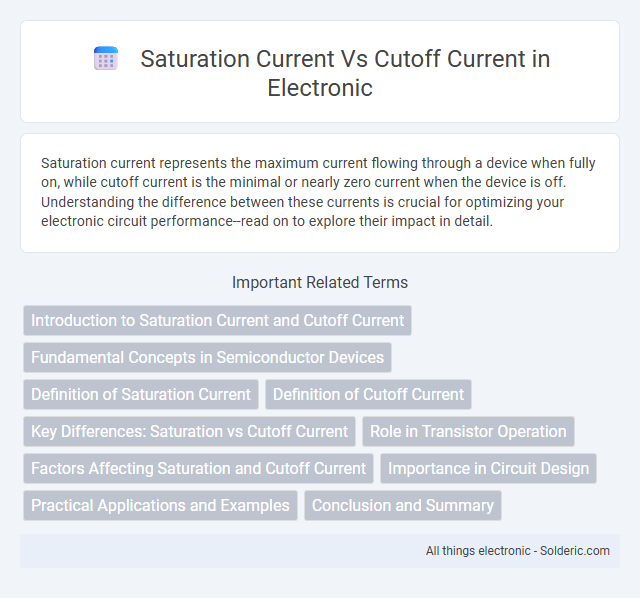Saturation current represents the maximum current flowing through a device when fully on, while cutoff current is the minimal or nearly zero current when the device is off. Understanding the difference between these currents is crucial for optimizing your electronic circuit performance--read on to explore their impact in detail.
Comparison Table
| Parameter | Saturation Current (Isat) | Cutoff Current (Icutoff) |
|---|---|---|
| Definition | Maximum current flowing through a device when fully on | Minimum near-zero current when the device is turned off |
| Device State | Fully saturated (on state) | Fully cut off (off state) |
| Current Magnitude | High current, limited by device capability | Negligible or zero current |
| Typical Application | Transistor saturation in switching circuits | Transistor cutoff in switching circuits |
| Impact on Circuit | Ensures conduction and allows maximum power transfer | Prevents conduction, acts as an open switch |
Introduction to Saturation Current and Cutoff Current
Saturation current represents the maximum current flowing through a transistor when it is fully on, indicating minimal resistance between collector and emitter terminals. Cutoff current denotes the negligible or zero current flowing when the transistor is fully off, meaning no base-emitter junction forward bias exists. These two states are fundamental for switching applications, ensuring a transistor operates either as a closed switch (saturation) or an open switch (cutoff).
Fundamental Concepts in Semiconductor Devices
Saturation current in semiconductor devices refers to the maximum current that flows when a transistor is fully on, representing the device's conduction limit under forward bias conditions. Cutoff current, however, is the minimal leakage current present when the transistor is off, indicating the device's non-conducting state under reverse bias or zero bias voltage. Understanding these currents is essential for analyzing transistor switching behavior, optimizing circuit performance, and designing efficient semiconductor components such as BJTs and MOSFETs.
Definition of Saturation Current
Saturation current is defined as the maximum current that flows through a transistor when it is fully on, allowing maximum charge carrier flow between the collector and emitter. It occurs when the base-emitter junction is forward biased and the collector-base junction is also forward biased, minimizing the transistor's internal resistance. This parameter is crucial for designing circuits to ensure the transistor operates efficiently in the saturation region without distortion.
Definition of Cutoff Current
Cutoff current is the minimum base current required to keep a transistor in the active region, below which the transistor switches off and no collector current flows. Saturation current, by contrast, is the maximum collector current when the transistor is fully on, with both junctions forward-biased. Understanding cutoff current is critical for designing amplifier circuits and switching applications to ensure reliable transistor operation.
Key Differences: Saturation vs Cutoff Current
Saturation current refers to the maximum current flowing through a transistor when it is fully on, allowing maximum charge carrier flow with minimal voltage drop across the device. Cutoff current, by contrast, is the negligible or zero current present when the transistor is fully off, preventing charge carrier flow and resulting in an open circuit state. The key difference lies in the operational states: saturation current represents the active, conducting state, while cutoff current indicates the inactive, non-conducting state of the transistor.
Role in Transistor Operation
Saturation current defines the maximum collector current when the transistor is fully on, allowing maximum current flow and minimal voltage drop across the collector-emitter junction. Cutoff current represents the near-zero collector current when the transistor is off, effectively blocking current flow and acting as an open switch. These currents determine the switching states of a transistor, critical for amplification and digital switching applications.
Factors Affecting Saturation and Cutoff Current
Saturation current is primarily affected by factors such as the transistor's base drive current, temperature variations, and the device's physical properties, including doping levels and geometry. Cutoff current depends on the transistor's leakage currents, intrinsic cutoff frequency, and the reverse leakage across junctions, which are influenced by temperature and manufacturing defects. Your device's performance can be optimized by carefully controlling these parameters to minimize power loss and enhance switching efficiency.
Importance in Circuit Design
Saturation current and cutoff current are critical parameters for transistor operation, directly influencing switching speed and power efficiency in circuit design. Saturation current represents the maximum current a transistor can conduct when fully switched on, ensuring minimal voltage drop and optimal performance in amplifiers and digital switches. Your choice of devices with appropriate saturation and cutoff currents affects noise margins, signal integrity, and overall reliability in analog and digital circuits.
Practical Applications and Examples
Saturation current, the maximum current a transistor can conduct when fully on, is crucial in power switching applications, ensuring efficient load control in devices like motors and LEDs. Cutoff current, effectively zero current flow, is essential in digital circuits for logic gate operation and signal switching, where transistors act as precise on/off switches. Understanding these currents helps you optimize transistor performance in practical scenarios like amplifier biasing and switching power supplies.
Conclusion and Summary
Saturation current represents the maximum current a transistor can conduct when fully on, whereas cutoff current is essentially zero, indicating the transistor is fully off. Understanding the distinction helps you optimize transistor operation in switching and amplification circuits, ensuring efficient performance. Properly managing these currents minimizes power loss and enhances device reliability.
Saturation current vs Cutoff current Infographic

 solderic.com
solderic.com